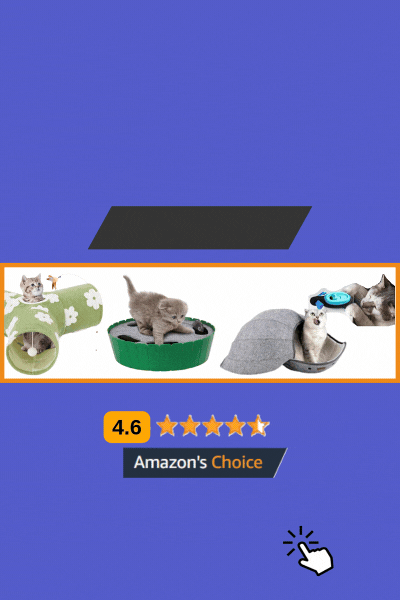Pet cats are comparatively more docile than those that have not been brought up in homes.
While it is safer for them to spend their maximum time inside the house, it isn’t advisable.
Survival of the fittest is something that we’ve grown up listening to about.
Ans in this case also, this holds true.
Exposure to the outside world results in cognitive development and hunting skills.
However, if your neighborhood isn’t that safe, it is best if you keep your felids inside.
To make sure that your cats develop their skills inspite of staying indoors, we bring to you a well researched and curated list of indoor activities that can develop their abilities.
1. Interactive Playtime With Wand Toys
Wand or teaser toys mimic the movement of prey and are a fantastic way to encourage your cat’s hunting instincts. Play in short bursts (10–15 minutes) twice a day.
Mimic the behavior of real prey—skitter across the floor like a mouse or flutter in the air like a bird. Let your cat catch the toy at the end to avoid frustration. Popular choices include feather wands, ribbon chasers, and telescopic rods.
2. Puzzle Feeders and Treat-Dispensing Toys
Cats are natural problem-solvers. Stimulate their brains by offering dry food or treats in puzzle feeders. These toys require your cat to paw, roll, or manipulate compartments to get the reward.
Rotate different feeders throughout the week to keep the novelty alive. It’s a perfect way to slow down eating and provide mental stimulation, especially during the day while you’re away.
See Also:
3. Create a DIY Hunting Trail
Hide kibble or treats around the house and let your cat “hunt” for their meal. Use a cardboard box with holes, paper bags, or cat-safe tunnels to hide the food.
This mimics their natural behavior of stalking and foraging. You can also create a treasure trail that leads to a food puzzle or surprise toy.
4. Cat Grass and Catnip Corners
Bring the outdoors inside with cat-safe plants. Cat grass (like wheatgrass or oat grass) aids digestion and gives cats something to nibble on.
Catnip (or silvervine for cats who don’t respond to catnip) can be sprinkled on toys, scratchers, or bedding to encourage playful behavior. Make sure all plants are non-toxic and kept in sturdy containers.
5. Climbing Structures and Vertical Space
Cats love to climb and perch up high. Offer vertical territory with cat trees, wall-mounted shelves, or window perches. Multi-level cat condos allow for exercise, scratching, and privacy.
Position them near windows for extra visual stimulation like birds and squirrels. For multi-cat households, vertical space also helps reduce territorial conflicts.
6. Birdwatching and Window Entertainment
Set up a cat-safe perch near a window and place a bird feeder outside to create a live-action show. Cats are natural watchers, and the movement of birds or squirrels outside offers hours of entertainment.
You can also play bird or fish videos on a tablet or TV specifically made for cats.
7. Schedule Short Training Sessions
Yes, cats can be trained! Use clicker training or treat-based reinforcement to teach basic commands like “sit,” “high five,” or “spin.” Training stimulates their brain and builds confidence and trust between you and your cat.
Keep sessions short and rewarding—no more than 5–10 minutes.
8. Rotate Toys Regularly
Even the best toys lose appeal if they’re always available. Create a toy rotation schedule: divide toys into groups and switch them out every few days.
This maintains novelty and prevents boredom. Include a mix of textures (plush, rubber, crinkly), shapes (mice, balls, kicker toys), and sounds (squeaky, bells).
9. Create Hide-and-Seek Nooks
Cats love cozy, enclosed spaces. Make hideouts using cardboard boxes, soft blankets, paper bags (handles removed), or collapsible cat cubes.
Hide toys or treats inside occasionally to turn them into fun discovery zones. These safe spots also help cats feel secure when they need a break from stimulation.
10. Simulate Nighttime Hunting
Cats are crepuscular, meaning they’re most active during dawn and dusk. Use this to your advantage. Before bedtime, engage your cat in a short, energetic play session followed by a high-protein meal.
This simulates a natural hunt-eat-sleep cycle and helps reduce nighttime zoomies or wake-up calls at 3 a.m.
Best Amazon Indoor Cat Toys You Should Try
Looking to add convenience to your enrichment routine? Here are some highly rated toys available on Amazon that support daily activities for cats of all breeds and ages:
Well, what are you waiting for?
Pick your favorite game and keep your feline engaged and on their claws (literally)!!
We hope you find this article helpful.

Nikita Rout is a passionate content writer at HowItSee.com, where she explores the wonders of animals, nature, and the curious questions that spark our imagination. With a love for research and a knack for simplifying complex topics, she brings clarity and creativity to every article she writes. When she’s not writing, you’ll likely find her reading about animal behavior or coming up with unique pet name ideas.

